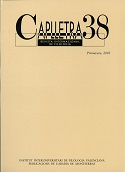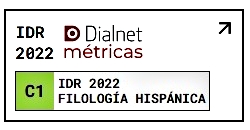Construcciones con avance estilístico en el catalán antiguo
DOI:
https://doi.org/10.7203/caplletra.38.4876Keywords:
construccions, català antic Abstract
Abstract
Stylistic Fronting is a phenomenon that has been intensively studied with respect to the symmetric Germanic Verb Second languages: Old/Modern Icelandic, Old/Modern Faeroese but also Middle English and Modern Yiddish. Standardly Stylistic Fronting is seen as an operation that moves an element in front of the finite verb in order to rescue the verb second constraint, in sentences that contain a subject gap. With the claim that the Old Romance languages are symmetric verb second languages, it soon followed that inverted elements in embedded contexts were analysed analogously to the Germanic inverted elements, i.e. as displaying Stylistic Fronting (Cardinaletti & Roberts 1991, Fontana 1993). In this paper I will present examples that show an nearly identical case of inversion in Old Catalan; nearly identical, because
in Old Catalan there are examples with stylistically fronted elements that don’t obey one of the formulated constraints of Stylistic Fronting: they appear next to a full subject. Furthermore, we find an interesting interplay between Stylistic Fronting and enclitic pronouns: not only that they disappear exactly at the same time in the history of Catalan, they also exclude each other during the time they were possible in Old Catalan. In this paper I hope to show that contrary to recent opinions Stylistic Fronting in Old Romance does have an effect on the information structure of the sentence comparable to the effect that topicalisation has on the information structural interpretation.
 Downloads
Downloads
Downloads
Published
How to Cite
-
Abstract414
-
PDF (Català)167
Issue
Section
License
Authors submitting work to Caplletra for publication must be the legitimate holder of the usage rights. Legitimacy for the purposes of publishing the work must also include images, tables, diagrams and any other materials that may complement the text, whether they are the author of such material or not.
Copyright: on publishing their work in the journal, the author grants Caplletra. Revista Internacional de Filologia usage rights (reproduction, distribution and public communication) for both the paper printed version and for the electronic version.
All work published in Caplletra is covered by the Creative Commons license type Attribution-NonCommercial-NoDerivatives 4.0 (CC BY-NC-ND 4.0).
RESPONSABILITY
Caplletra. Revista Internacional de Filologia does not necessarily identify with the points of view expressed in the papers it publishes.
Caplletra. Revista Internacional de Filologia accepts no responsibility whatsoever for any eventual infringement of intellectual property rights on the part of authors.






